272 MERCEDES-BENZ AMG GT S 2016 C190 Owner's Manual
[x] Cancel search | Manufacturer: MERCEDES-BENZ, Model Year: 2016, Model line: AMG GT S, Model: MERCEDES-BENZ AMG GT S 2016 C190Pages: 290, PDF Size: 6.73 MB
Page 11 of 290

Out of position (troubleshooting) ..... 82
Setting ............................................. 82
Storing settings (memory func-
tion) .................................................84
Storing the parking position ............. 83
F
Favorites
Overview ........................................ 203
Features ............................................. 212
Filler cap
see Refueling
Flat tire
Changing a wheel/mounting the
spare wheel ................................... 272
Preparing the vehicle ..................... 242
TIREFIT kit ...................................... 242
Floormats ........................................... 226
Frequencies
Mobile phone ................................. 279
Two-way radio ................................ 279
Fuel
Additives ........................................ 283
Consumption statistics .................. 154
Displaying the current consump-
tion ................................................ 153
Displaying the range ...................... 153
Driving tips .................................... 123
E10 ................................................ 282
Fuel gauge ....................................... 30
Grade (gasoline) ............................ 282
Important safety notes .................. 282
Problem (malfunction) ................... 119
Refueling ........................................ 117
Tank content/reserve fuel ............. 282
Fuel filler flap
Closing ........................................... 118
General information ....................... 118
Opening ......................................... 118
Problem (malfunction) ................... 119
Fuel level
Calling up the range (on-board
computer) ...................................... 153
Fuel tank
Capacity ........................................ 282
Problem (malfunction) ................... 119 Fuses
Allocation chart ............................. 253
Before changing ............................. 253
Fuse box in the cargo compart-
ment .............................................. 253
Fuse box in the front-passenger
footwell .......................................... 253
Important safety notes .................. 252
G
G-Meter (on-board computer) .......... 163
Garage door opener
Clearing the memory ..................... 226
General notes ................................ 223
Important safety notes .................. 223
Opening/closing the garage doo r..2 25
Problems when programming ........2 25
Programming (button in the rear-
view mirror) ................................... 224
Synchronizing the rolling code ....... 224
Gasoline ............................................. 282
Gear indicator (on-board com-
puter) ..................................................1 62
Genuine parts ...................................... 21
Glove box ...........................................2 10
Google™ Local Search
see also Digital Operator's Man-
ual ..................................................2 00
H
Handbrake
see Parking brake
Handwriting recognition
Switching text reader function
on/off ............................................ 203
Touchpad ....................................... 202
Hazard warning lamps ........................ 88
Head restraints
Adjusting ......................................... 77
Headlamps
Cleaning system (notes) ................ 285
Fogging up ....................................... 89
see Automatic headlamp mode
Heating
see Climate control
High beam flasher ............................... 87
Index9
Page 19 of 290
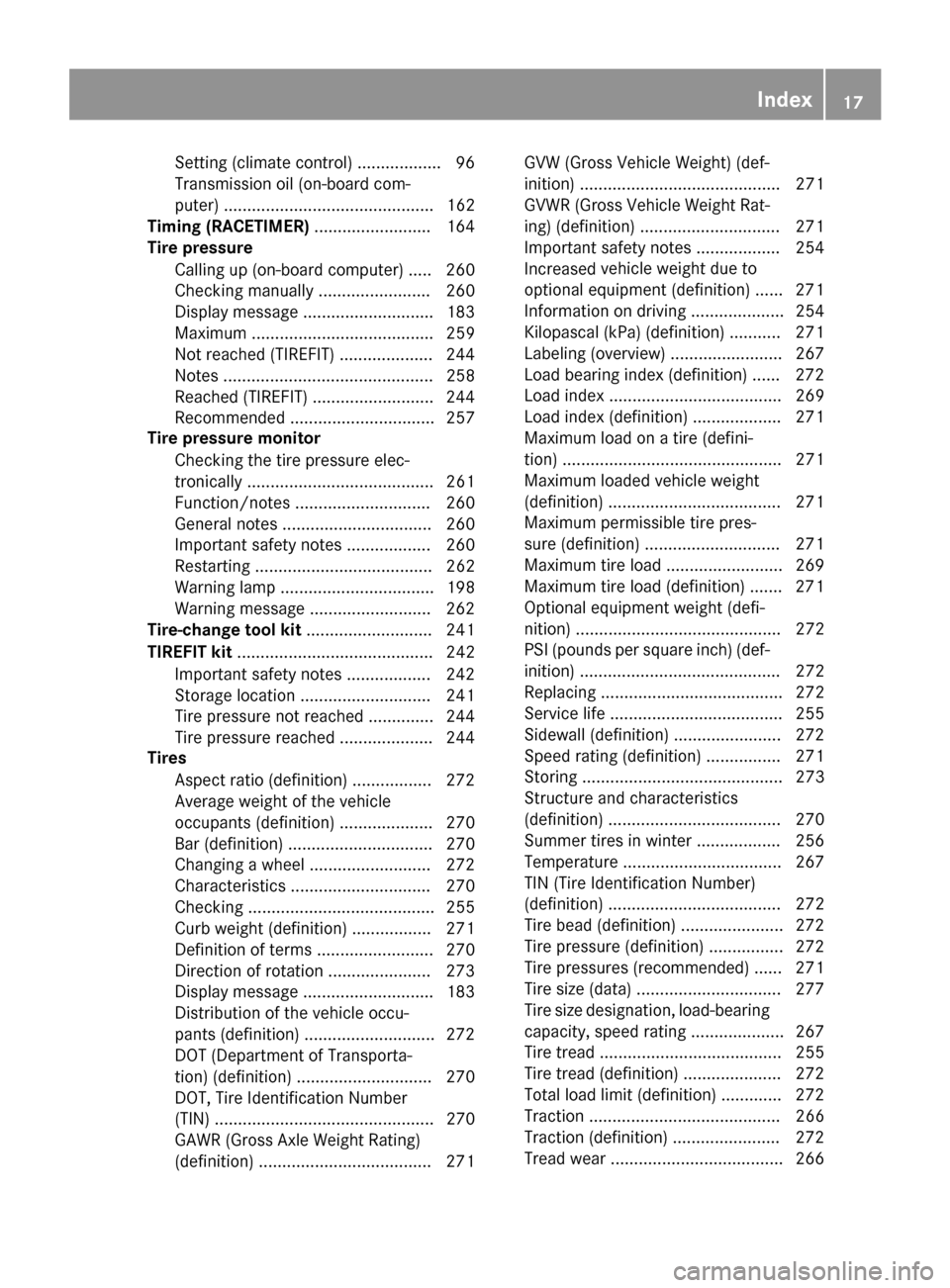
Setting (climate control) .................. 96
Transmission oil (on-board com-
puter) ............................................. 162
Timing (RACETIMER) ......................... 164
Tire pressure
Calling up (on-board computer) ..... 260
Checking manually ........................ 260
Display message ............................ 183
Maximum ....................................... 259
Not reached (TIREFIT) .................... 244
Notes ............................................. 258
Reached (TIREFIT) .......................... 244
Recommended ............................... 257
Tire pressure monitor
Checking the tire pressure elec-
tronically ........................................ 261
Function/notes ............................. 260
General notes ................................ 260
Important safety notes .................. 260
Restarting ...................................... 262
Warning lamp ................................. 198
Warning message .......................... 262
Tire-change tool kit ........................... 241
TIREFIT kit .......................................... 242
Important safety notes .................. 242
Storage location ............................ 241
Tire pressure not reached .............. 244
Tire pressure reached .................... 244
Tires
Aspect ratio (definition) ................. 272
Average weight of the vehicle
occupants (definition) .................... 270
Bar (definition) ............................... 270
Changing a wheel .......................... 272
Characteristics .............................. 270
Checking ........................................ 255
Curb weight (definition) ................. 271
Definition of terms ......................... 270
Direction of rotation ...................... 273
Display message ............................ 183
Distribution of the vehicle occu-
pants (definition) ............................ 272
DOT (Department of Transporta-
tion) (definition) ............................. 270
DOT, Tire Identification Number
(TIN) ............................................... 270
GAWR (Gross Axle Weight Rating)
(definition) ..................................... 271 GVW (Gross Vehicle Weight) (def-
inition) ........................................... 271
GVWR (Gross Vehicle Weight Rat-
ing) (definition) .............................. 271
Important safety notes .................. 254
Increased
vehi
cle weight due to
optional equipment (definition) ...... 271
Information on driving .................... 254
Kilopascal (kPa) (definition) ........... 271
Labeling (overview) ........................ 267
Load bearing index (definition) ...... 272
Load index ..................................... 269
Load index (definition) ................... 271
Maximum load on a tire (defini-
tion) ............................................... 271
Maximum loaded vehicle weight
(definition) ..................................... 271
Maximum permissible tire pres-
sure (definition) ............................. 271
Maximum tire load ......................... 269
Maximum tire load (definition) ....... 271
Optional equipment weight (defi-
nition) ............................................ 272
PSI (pounds per square inch) (def-
inition) ........................................... 272
Replacing ....................................... 272
Service life ..................................... 255
Sidewall (definition) ....................... 272
Speed rating (definition) ................ 271
Storing ........................................... 273
Structure and characteristics
(definition) ..................................... 270
Summer tires in winter .................. 256
Temperature .................................. 267
TIN (Tire Identification Number)
(definition) ..................................... 272
Tire bead (definition) ...................... 272
Tire pressure (definition) ................ 272
Tire pressures (recommended) ...... 271
Tire size (data) ............................... 277
Tire size designation, load-bearing
capacity, speed rating .................... 267
Tire tread ....................................... 255
Tire tread (definition) ..................... 272
Total load limit (definition) ............. 272
Traction ......................................... 266
Traction (definition) ....................... 272
Tread wear ..................................... 266
Index17
Page 20 of 290
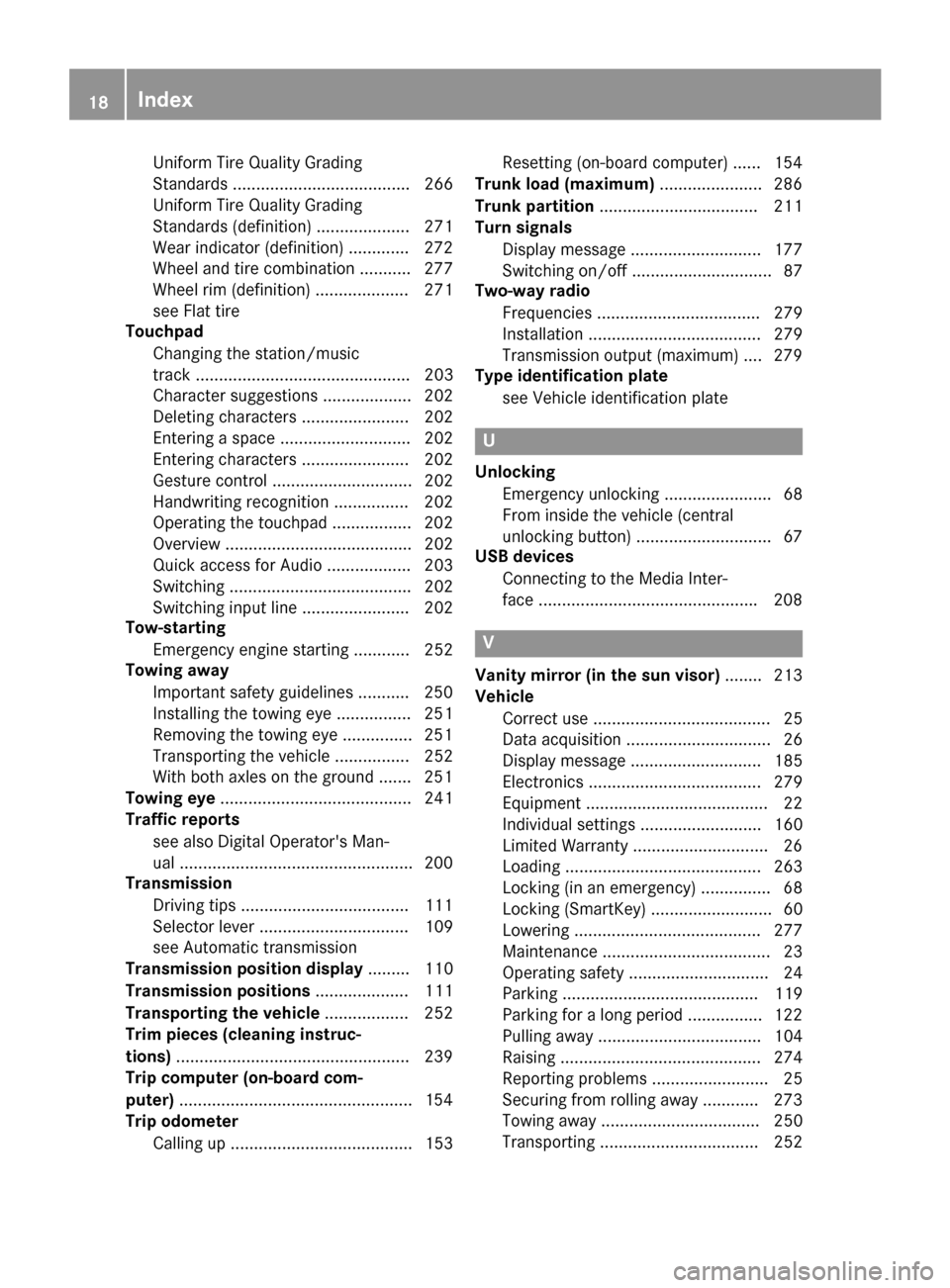
Uniform Tire Quality Grading
Standards ...................................... 266
Uniform Tire Quality Grading
Standards (definition) .................... 271
Wear indicator (definition) .............272
Wheel and tire combination ........... 277
Wheel rim (definition) .................... 271
see Flat tire
Touchpad
Changing the station/music
track .............................................. 203
Character suggestions ................... 202
Deleting characters ....................... 202
Entering a space ............................ 202
Entering characters ....................... 202
Gesture control .............................. 202
Handwriting recognition ................ 202
Operating the touchpad ................. 202
Overview ........................................ 202
Quick access for Audio .................. 203
Switching ....................................... 202
Switching input line ....................... 202
Tow-starting
Emergency engine starting ............ 252
Towing away
Important safety guidelines ........... 250
Installing the towing eye ................ 251
Removing the towing eye ...............2 51
Transporting the vehicle ................ 252
With both axles on the ground ....... 251
Towing eye ......................................... 241
Traffic reports
see also Digital Operator's Man-
ual ..................................................2 00
Transmission
Driving tips ....................................1 11
Selector lever ................................ 109
see Automatic transmission
Transmission position display ......... 110
Transmission positions .................... 111
Transporting the vehicle .................. 252
Trim pieces (cleaning instruc-
tions) ..................................................2 39
Trip computer (on-board com-
puter) ..................................................1 54
Trip odometer
Calling up ....................................... 153 Resetting (on-board computer) ...... 154
Trunk load (maximum) ......................286
Trunk partition .................................. 211
Turn si
gnals
Display message ............................ 177
Switching on/off .............................. 87
Two-way radio
Frequencies ................................... 279
Installation ..................................... 279
Transmission output (maximum) .... 279
Type identification plate
see Vehicle identification plate
U
UnlockingEmergency unlocking ....................... 68
From inside the vehicle (central
unlocking button) .............................6 7
USB devices
Connecting to the Media Inter-
face .............................................. .208
V
Vanity mirror (in the sun visor) ........213
Vehicle
Correct use ...................................... 25
Data acquisition ............................... 26
Display message ............................ 185
Electronics ..................................... 279
Equipment ....................................... 22
Individual settings .......................... 160
Limited Warranty .............................2 6
Loading .......................................... 263
Locking (in an emergency) ............... 68
Locking (SmartKey) .......................... 60
Lowering ........................................ 277
Maintenance .................................... 23
Operating safety .............................. 24
Parking .......................................... 119
Parking for a long period ................ 122
Pulling away ................................... 104
Raising ........................................... 274
Reporting problems ......................... 25
Securing from rolling away ............ 273
Towing away .................................. 250
Transporting .................................. 252
18Index
Page 21 of 290
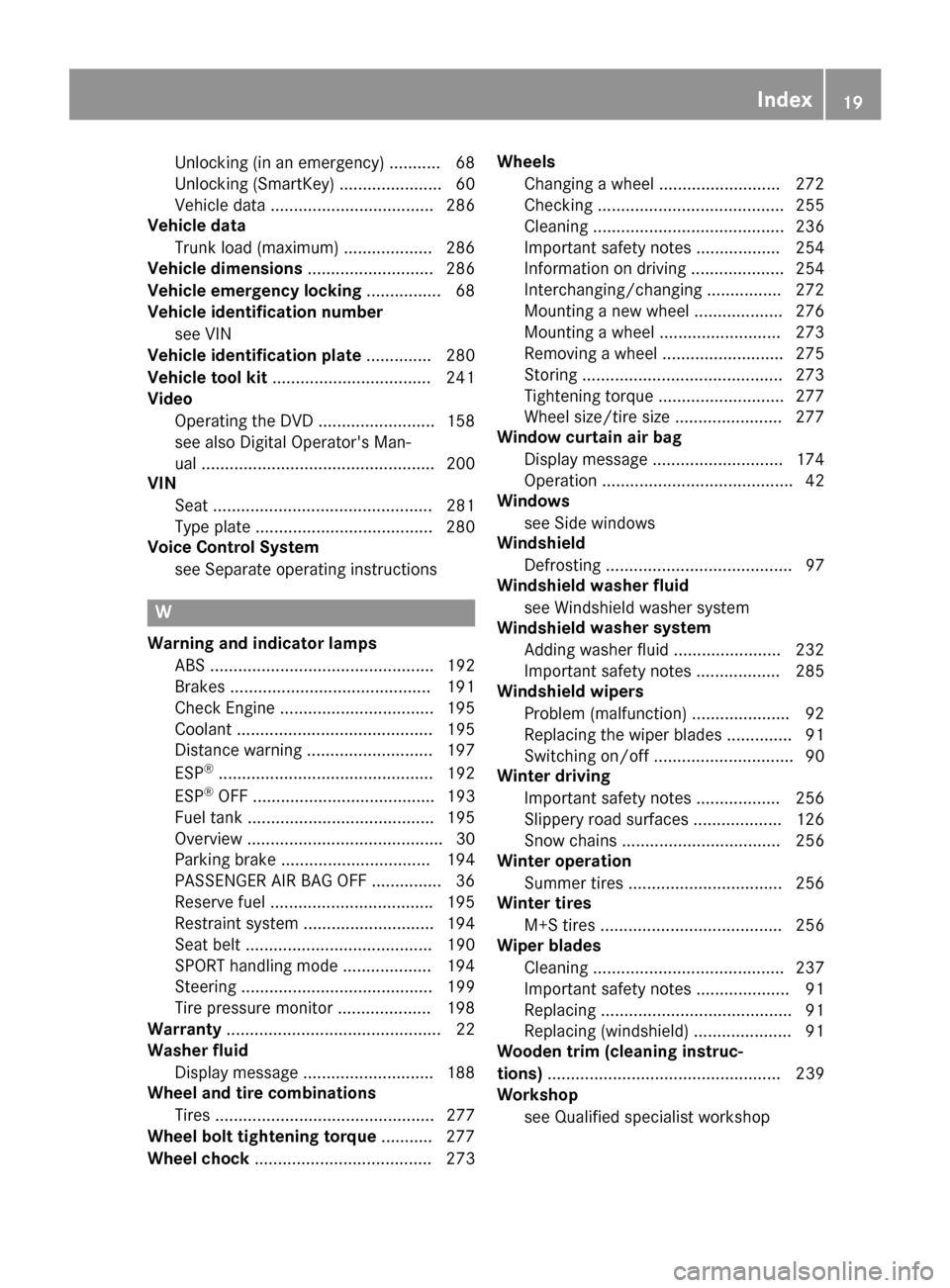
Unlocking (in an emergency) ........... 68
Unlocking (SmartKey) ......................60
Vehicle data ................................... 286
Vehicle data
Trunk load (maximum) ................... 286
Vehicle dimensions ........................... 286
Vehicle emergency locking ................ 68
Vehicle identification number
see VIN
Vehicle identification plate .............. 280
Vehicle tool kit .................................. 241
Video
Operating the DVD .........................1 58
see also Digital Operator's Man-
ual ..................................................2 00
VIN
Seat ............................................... 281
Type plate ...................................... 280
Voice Control System
see Separate operating instructions
W
Warning and indicator lampsABS ................................................ 192
Brakes ...........................................1 91
Check Engine ................................. 195
Coolant .......................................... 195
Distance warning ........................... 197
ESP
®.............................................. 192
ESP®OFF ....................................... 193
Fuel tank ........................................ 195
Overview .......................................... 30
Parking brake ................................ 194
PASSENGER AIR BAG OFF ...............3 6
Reserv efuel .................................. .195
Restraint system ............................ 194
Seat belt ........................................ 190
SPORT handling mode ................... 194
Steering ......................................... 199
Tire pressure monitor .................... 198
Warranty .............................................. 22
Washer fluid
Display message ............................ 188
Wheel and tire combinations
Tires ............................................... 277
Wheel bolt tightening torque ........... 277
Wheel chock ...................................... 273 Wheels
Changing a wheel .......................... 272
Checking ........................................ 255
Cleaning ......................................... 236
Important safety notes .................. 254
Information on driving .................... 254
Interchanging/changing ................ 272
Mounting a new wheel ................... 276
Mounting a wheel .......................... 273
Removing a wheel .......................... 275
Storing ...........................................2 73
Tightening torque ........................... 277
Wheel size/tire size ....................... 277
Window curtain air bag
Display message ............................ 174
Operation ......................................... 42
Windows
see Side windows
Windshield
Defrosting ........................................ 97
Windshield washer fluid
see Windshield washer system
Windshiel d w
asher system
Adding washer fluid ....................... 232
Important safety notes .................. 285
Windshield wipers
Problem (malfunction) ..................... 92
Replacing the wiper blades .............. 91
Switching on/off .............................. 90
Winter driving
Important safety notes .................. 256
Slippery road surfaces ................... 126
Snow chains .................................. 256
Winter operation
Summer tires ................................. 256
Winter tires
M+S tires ....................................... 256
Wiper blades
Cleaning ......................................... 237
Important safety notes .................... 91
Replacing ......................................... 91
Replacing (windshield) ..................... 91
Wooden trim (cleaning instruc-
tions) .................................................. 239
Workshop
see Qualified specialist workshop
Index19
Page 244 of 290

Flat tire
Preparing the vehicle
Your vehiclemay be equipped with:
RaTIREFI Tkit (Ypage 241)
Information on changing and mounting wheels
(
Ypage 272).
XStop th evehicl eon solid, non-slippery and
leve lground ,as far away as possible from
traffic.
XSwitc hon th ehazard warning lamps.
XSecur eth evehicl eagainst rollin gaway
(Ypage 119).
XIf possible ,brin gth efron twheels int oth e
straight-ahead position .
XSwitchoff th eengine.
XWit hKEYLESS-G Ostar tfunction or vehi-
cles with KEYLESS-GO: open thedriver' s
door .
The on-board electronics no whave status 0.
This is th esam eas th eSmartKey having been
removed.
or
XRemove th eSmartKey from th eignition lock.
XMak esure that th epassenger sare no tendan -
gered as they do so. Mak esure that no on eis
near th edanger area while awhee lis bein g
changed. Anyon ewho is no tdirectly assisting
in th ewhee lchang eshould, for example ,
stand behind th ebarrier.
XGet out of th evehicle. Pay attention to traffic
condition swhen doin gso.
XClose th edriver' sdoor .
TIREFIT kit
Important safety notes
TIREFI Tis atire sealant.
You can use TIREFI Tto seal punctures of up to
0.16 in (4 mm), particularl ythose in th etire
tread. You can use TIREFI Tat outside tempera-
tures down to Ò4 ‡ (Ò20†).
GWARNING
In th efollowin gsituations, th etire sealant is
unable to provid esufficien tbreakdown assis-
tance ,as it is unable to seal th etire properly:
Rthere are cut sor punctures in th etire larger
than those mentioned above.
Rth ewhee lrim is damaged.
Ryou hav edriven at ver ylow tire pressures or
on aflat tire.
There is aris kof an accident.
Do no tdrive th evehicle. Contac t aqualified
specialist workshop .
GWARNING
The tire sealant is harmful and causes irrita-
tion .It mus tno tcome into contact wit hyour
skin ,eyes or clothin gor be swallowed .Do no t
inhale TIREFI Tfumes. Kee ptire sealant away
from children .There is aris kof injury.
If you come into contact wit hth etire sealant ,
observ eth efollowing:
RRinse off th etire sealant from your skin
immediately wit hwater.
RIf th etire sealant comes into contact wit h
your eyes ,immediately rinse them thor-
oughly wit hclean water.
RIf tire sealant is swallowed ,immediately
rinse your mout hout thoroughl yand drink
plenty of water. Do no tinduc evomiting,
and see kmedica lattention immediately.
RImmediately chang eout of clothin gwhic h
has come into contact wit htire sealant .
RIf an allergic reaction occurs, see kmedica l
attention immediately.
!Do no toperate th etire inflation compressor
for longer than te nminute sat atime without
a break. It may otherwise overheat.
The tire inflation compressor can be operate d
again once it has cooled down .
Comply wit hth emanufacturer' ssafet yinstruc -
tion son th etire inflation compressor label and
on th etire sealant bottle.
242Flat tire
Breakdown assis tance
Page 258 of 290
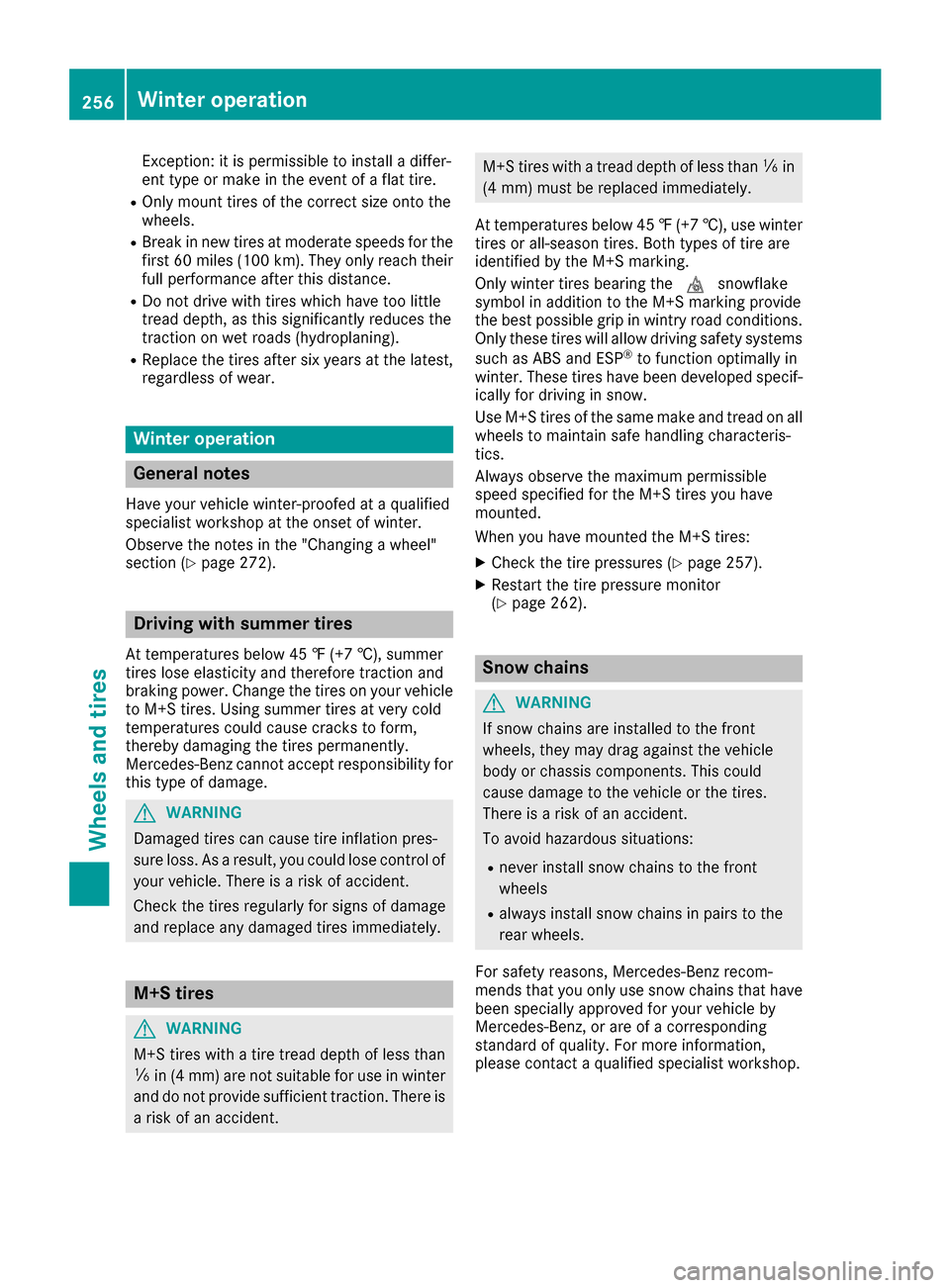
Exception: it is permissible to install a differ-
ent type or make in the event of a flat tire.
ROnly mount tires of the correct size onto the
wheels.
RBreak in new tires at moderate speeds for thefirst 60 miles (100 km). They only reach their
full performance after this distance.
RDo not drive with tires which have too little
tread depth, as this significantly reduces the
traction on wet roads (hydroplaning).
RReplace the tires after six years at the latest,
regardless of wear.
Winter operation
General notes
Have your vehicle winter-proofed at a qualified
specialist workshop at the onset of winter.
Observe the notes in the "Changing a wheel"
section (
Ypage 272).
Driving with summer tires
At temperatures below 45 ‡ (+7 †), summer
tires lose elasticity and therefore traction and
braking power. Change the tires on your vehicle
to M+S tires. Using summer tires at very cold
temperatures could cause cracks to form,
thereby damaging the tires permanently.
Mercedes-Benz cannot accept responsibility for
this type of damage.
GWARNING
Damaged tires can cause tire inflation pres-
sure loss. As a result, you could lose control of
your vehicle. There is a risk of accident.
Check the tires regularly for signs of damage
and replace any damaged tires immediately.
M+S tires
GWARNING
M+S tires with a tire tread depth of less than
ã in (4 mm) are not suitable for use in winter
and do not provide sufficient traction. There is
a risk of an accident.
M+S tires with a tread depth of less than ãin
(4 mm) must be replaced immediately.
At temperatures below 45 ‡(+7 †), use winter
tires or all-season tires. Both types of tire are
identified by the M+S marking.
Only winter tires bearing the isnowflake
symbol in addition to the M+S marking provide
the best possible grip in wintry road conditions.
Only these tires will allow driving safety systems
such as ABS and ESP
®to function optimally in
winter. These tires have been developed specif-
ically for driving in snow.
Use M+S tires of the same make and tread on all
wheels to maintain safe handling characteris-
tics.
Always observe the maximum permissible
speed specified for the M+S tires you have
mounted.
When you have mounted the M+S tires:
XCheck the tire pressures (Ypage 257).
XRestart the tire pressure monitor
(Ypage 262).
Snow chains
GWARNING
If snow chains are installed to the front
wheels, they may drag against the vehicle
body or chassis components. This could
cause damage to the vehicle or the tires.
There is a risk of an accident.
To avoid hazardous situations:
Rnever install snow chains to the front
wheels
Ralways install snow chains in pairs to the
rear wheels.
For safety reasons, Mercedes-Benz recom-
mends that you only use snow chains that have
been specially approved for your vehicle by
Mercedes-Benz, or are of a corresponding
standard of quality. For more information,
please contact a qualified specialist workshop.
256Winter operation
Wheels and tires
Page 274 of 290
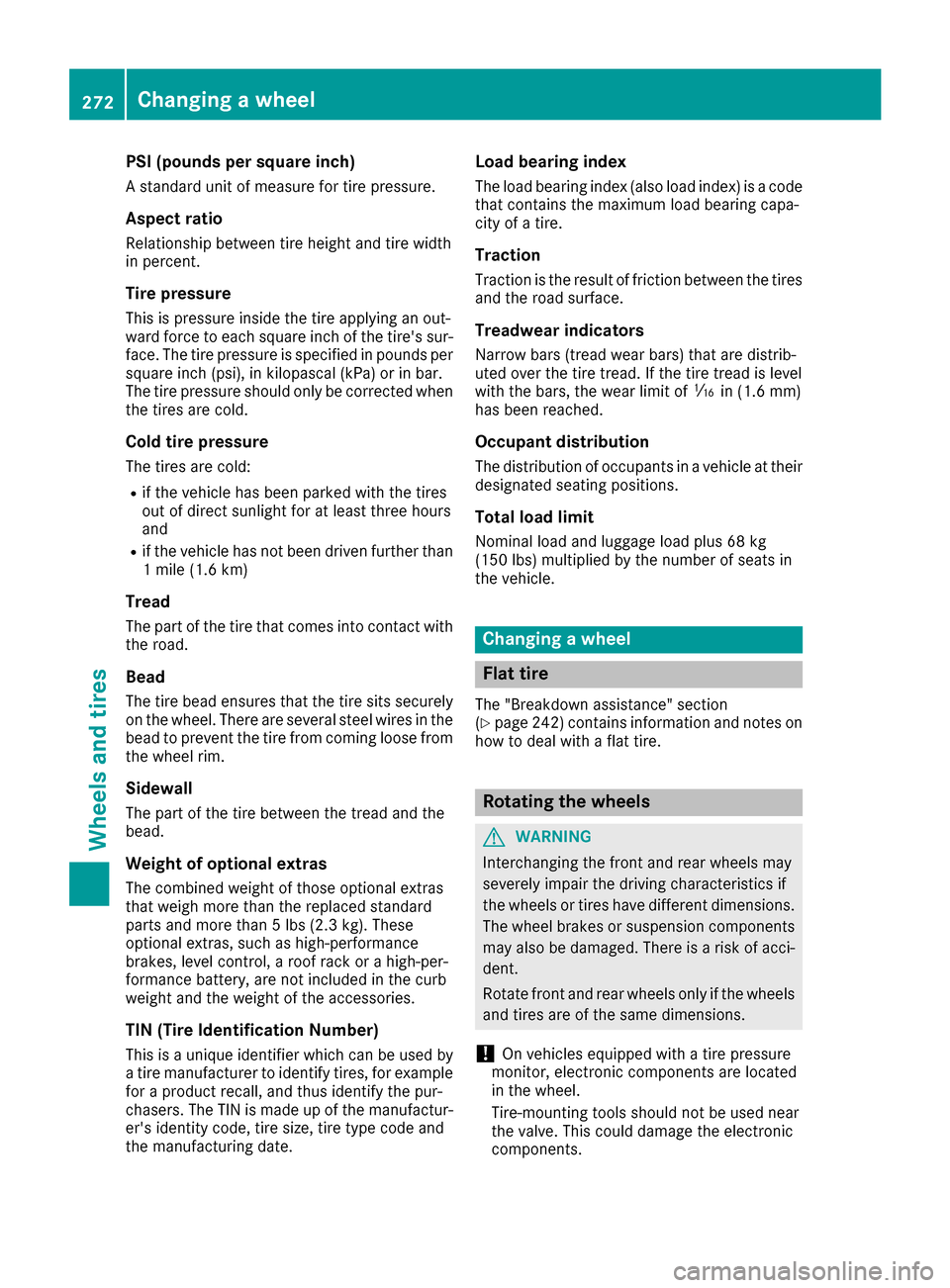
PSI (pounds per square inch)
A standard unit of measure for tire pressure.
Aspect ratio
Relationship between tire height and tire width
in percent.
Tire pressure
This is pressure inside the tire applying an out-
ward force to each square inch of the tire's sur-
face. The tire pressure is specified in pounds per
square inch (psi), in kilopascal (kPa) or in bar.
The tire pressure should only be corrected when
the tires are cold.
Cold tire pressure
The tires are cold:
Rif the vehicle has been parked with the tires
out of direct sunlight for at least three hours
and
Rif the vehicle has not been driven further than
1 mile (1.6 km)
Tread
The part of the tire that comes into contact with
the road.
Bead
The tire bead ensures that the tire sits securely
on the wheel. There are several steel wires in the
bead to prevent the tire from coming loose fromthe wheel rim.
Sidewall
The part of the tire between the tread and the
bead.
Weight of optional extras
The combined weight of those optional extras
that weigh more than the replaced standard
parts and more than 5 lbs (2.3 kg). These
optional extras, such as high-performance
brakes, level control, a roof rack or a high-per-
formance battery, are not included in the curb
weight and the weight of the accessories.
TIN (Tire Identification Number)
This is a unique identifier which can be used by
a tire manufacturer to identify tires, for example
for a product recall, and thus identify the pur-
chasers. The TIN is made up of the manufactur-
er's identity code, tire size, tire type code and
the manufacturing date.
Load bearing index
The load bearing index (also load index) is a code
that contains the maximum load bearing capa-
city of a tire.
Traction
Traction is the result of friction between the tires
and the road surface.
Treadwear indicators
Narrow bars (tread wear bars) that are distrib-
uted over the tire tread. If the tire tread is level
with the bars, the wear limit of áin (1.6 mm)
has been reached.
Occupant distribution
The distribution of occupants in a vehicle at their
designated seating positions.
Total load limit
Nominal load and luggage load plus 68 kg
(150 lbs) multiplied by the number of seats in
the vehicle.
Changing a wheel
Flat tire
The "Breakdown assistance" section
(Ypage 242) contains information and notes on
how to deal with a flat tire.
Rotating the wheels
GWARNING
Interchanging the front and rear wheels may
severely impair the driving characteristics if
the wheels or tires have different dimensions. The wheel brakes or suspension components
may also be damaged. There is a risk of acci-
dent.
Rotate front and rear wheels only if the wheels and tires are of the same dimensions.
!On vehicles equipped with a tire pressure
monitor, electronic components are located
in the wheel.
Tire-mounting tools should not be used near
the valve. This could damage the electronic
components.
272Changing a wheel
Wheels and tires
Page 278 of 290

XUnscrew the uppermost wheel bolt com-
pletely.
XScrew alignment bolt:into the thread
instead of the wheel bolt.
XUnscrew the remaining wheel bolts fully.
XRemove the wheel.
Mounting a new wheel
GWARNING
Oiled or greased wheel bolts or damaged
wheel bolts/hub threads can cause the wheel bolts to come loose. As a result, you could
lose a wheel while driving. There is a risk of
accident.
Never oil or grease wheel bolts. In the event of
damage to the threads, contact a qualified
specialist workshop immediately. Have the
damaged wheel bolts or hub threads
replaced/renewed. Do not continue driving.
GWARNING
If you tighten the wheel bolts or wheel nuts
when the vehicle is raised, the jack could tip
over. There is a risk of injury.
Only tighten the wheel bolts or wheel nuts
when the vehicle is on the ground.
Always pay attention to the instructions and
safety notes in the "Changing a wheel" section
(
Ypage 272).
Only use wheel bolts that have been designed
for the wheel and the vehicle. For safety rea-
sons, Mercedes-Benz recommends that you
only use wheel bolts which have been approved for Mercedes-Benz vehicles and the respective
wheel.
!AMG ceramic high performance compound
brake system:
When detaching or attaching the wheel, the
wheel rim may hit against the ceramic brake
disc and damage it.
For this reason, you should proceed carefully.
Request the assistance of a second person or
use a second alignment bolt.
!To prevent damage to the paintwork, hold
the wheel securely against the wheel hub
while screwing in the first wheel bolt.
:Wheel bolt
XClean the wheel and wheel hub contact sur-
faces.
XSlide the wheel to be mounted onto the align-
ment bolt and push it on.
XTighten the wheel bolts until they are finger-
tight.
XUnscrew the alignment bolt.
XTighten the last wheel bolt until it is finger-
tight.
276Changing a wheel
Wheels and tires